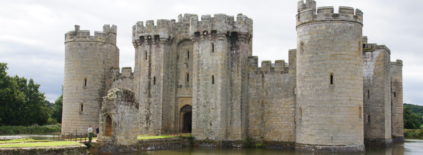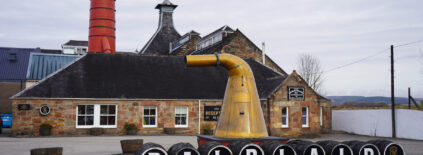A good Single Malt Scotch Whisky will be well crafted and all the details finely attended to by the Distillery that produced it. The nuances that the Distilleries use to influence the flavours of the whisky can produce some true magic in liquid form.
So you want to know more about how Whisky is made? Scroll a bit further and let’s cover off the key aspects of crafting this marvelous drink. Over 200 years of crafting this spirit and not a lot has ultimately changed in that time.
A Little About Me and My Love of Scotch

I came into my whisky appreciation over time, as many do, as an acquired taste.
My father loved his scotch – Dewar’s on the rocks. That was the order every time we went out and I knew it by heart. When he passed away I looked for little ways to connect with his memory and keep him alive in my soul. During one of the rougher months following his passing I decided I would try his favorite drink – Dewar’s on the rocks.
It was potent and I didn’t care for the taste. But I’m a stubborn person so a few months later I tried again, and on second tasting it wasn’t too bad. I did this a few more times over the period of months and came to slowly appreciate whisky during this period of time.
Years later I moved to the UK and being in such close proximity to proper scotch I branched out my tasting to include Single Malts and a wider variety of distilleries, brands and malts. I found that my Scotch tastes ran up a higher tab than my father’s preferences, but I grew to have a real appreciation and affinity for the Scottish “water of life”.
This appreciation led me to visit 12 Whisky Distilleries and spend my free time learning about the nuances and art of making Whisky.
The 3 Ingredients Required..
Most Distilleries start their tours in a similar vein – highlighting the 3 key ingredients to crafting a beautiful whisky:
- Water
- Barley
- Yeast
It seems simple, but it leaves out other critical ingredients that can be included:
- Peat, to add smokiness to the Barley
- Oak, to add flavour to the whisky as it matures
Quality is another factor in al lof the ingredients. The reason a large amount of distilleries are situated in the Speyside reason is because of the quality of the water available there. Every distillery needs access to a water source as the base for any whisky they will create.
The Steps to Create Whisky
1. Malting & Milling
The goal of Malting is to prepare the barley to convert the starch to sugars which can be fermented into alcohol.
The entire Malting process really breaks down into 3 steps before the barley is ready to move onto the Mashing stage:
- Barley is soaked in warm water for around 2 days to convince it that spring has arrived, and it’s time to start growing. When the barley starts to grow shoots then this process is stopped and we move onto the drying process.
- After soaking it is then dried out in an even manner over time. This traditionally was done in the malting house at a distillery, which were distinctively designed with the kiln roofs that allowed for good ventilation. Modern malting is more commonly done in big batches using a large bus sized drum that rotates slowly – this helps to encourage the barley to grow, and also can help to knock off any shoots that grow during the process.
- For smokey whisky Peat can be introduced at the drying stage. The Peat will be burned beneath the barley to allow the smokiness of the Peat to flavour the barley.
At the end of the Malting stage we have “malt”, the produce of the dried (and smoked) barley. This will then be passed through a mill that will break down the husk and expose the starch.
Most distilleries have used the same mill for decades; and they were so well built that the original company was put out of business by the own reliability of their product.
This ground down product is called “grist” and it is what will be passed to the Mashing stage.
2. Mashing
The goal of Mashing is to extract the sugars from the grist.
The grist is transferred to a mash tun and then it will be washed with hot water at different temperatures to extract the most usable sugars possible. Different distilleries will run the water through at varying temperatures depending on their processes, but most will do this at least twice in order to get the majority of the sugars out of the starch.
The water will be locally sourced and is often seen as the key component to a good whisky. Most distilleries pride themselves on their water reserve and the purity of it for what they make. This is also one of the key reasons that so many distilleries are built in the Speyside region of Scotland, where the water is pure and has been enhanced by passing through the minerals of that region.
The grist and the water are combined in the mash tun to make “mash”, and this will be steeped for several hours. A comb will slowly move through the mash stirring it up during this time to help the sugars dissolve into the water. The resulting product is called “wort”, and the first two batches of water (first at a lower temp and the second at a higher), will be transferred next to the washbacks for the fermentation process.
The third batch of wort (produced by using an even hotter water) will be passed to a holding tank and will be used during the next mashing process as the first batch of water to be passed through. The remaining sugars in that wort will form a base for the first rinse of the next mashing process.
The remains of the grist, now without any of the starchy sugars, will be collected and turned into animal feed pellets. These are often sold back to farmers to feed their livestock, though in some cases it’s donated to local farmers rather than sold. One of the themes in whisky making is that very little is wasted – already we’ve extracted as much sugar as possible and saved a batch of light wort to be re-used, and we have all the remains of the barley to sell onto farmers.
Mash Tuns themselves can be made of wood or stainless steel, and are usually covered. One of the only uncovered ones that I’ve seen as at Deanston Distillery, so it was unique to get to see the process with a bit more clarity (rather than looking through a small window to see how it is getting on).
3. Fermentation
The goal of Fermentation is to create alcohol – and ultimately it leads to a really strong beer like substance.
The wort, created during the Mashing process, will be cooled down before being passed into Washbacks. Washbacks are a large (very large) tank where the fermentation process occurs. They’re often 2-3 stories tall and made of wood; though some have started being made of stainless steel. Distilleries have differing opinions over which to use; wood is very traditional but stainless steel is easier to clean. The ease of cleaning the steel washbacks means that distilleries with them can do more experimental batches. Since these could have a slightly differing flavor those with wooden washbacks wouldn’t want to test them since the cleaning process can be more difficult with the porous wood.
The cooling of the wort can be done in a few different ways, but it usually involves passing it through a cooling tank before sending it to the Washbacks. During the Dalwhinnie Distillery tour they explained that because their cooling tank is outside and located in the cold Highlands that the cooling process during winter produces a very different flavour palate than any cooling done in warmer months. In fact it was so different that they’ve started bottling their winter casks as “Dalwhinnie Winter’s Gold”. They confirmed the only difference between that bottle and their “Dalwhinnie 15” was when the time of year that cooling was done during. That difference alone expresses how important the cooling process is for the wort to become whisky.
Once the wort is in the Washback the Yeast is then added, and this is what kick-starts the actual fermentation.
The yeast then mixes with the sugars in the wort and works on turning the sugars into alcohol. This will continue for 48 – 72 hours within the washback, and most will be equipped with a fan at the very top to keep the bubbles from bursting through the top of the washback as the fermentation process grows.
Both the yeast and the length of fermentation can have a small impact on the flavour of the whisky. Though the specifics around this are not very specific, there is a great blog article from Whisky Science around Fermentation Flavors that is a good read on the subject.
At the end of 48 hours the resulting liquid is now a “wash”, or a low strength alcohol. This alcohol will be under 10% ABV and will be akin to strong beer. This is not yet strong enough to be whisky, and in order to get the alcohol concentration higher we’ll pass the Wash to the Distillation process.
4. Distillation
The goal of Distillation is to purify and increase the alcohol quality from the Wash, to create a spirit.
With Scotch the wash will go through a double distillation process – in two different type of copper pot stills. Copper stills will be used at all the whisky distilleries in Scotland and is the standard material used. The shape of the stills will produce a slightly different spirit and can have an impact on the flavor, so this is another area where a distillery can distinguish themselves in taste. The key difference in shape is usually around how tall or short the still is and the shape. The shorter ones often have a punchier flavor but are less refined, whereas the taller stills will be lighter.
The process of distillation starts when the wash is added to the first (of two) pot stills and heated up. The alcohol will rise a vapor to the top of the still and then will be cooled in a condenser back down to a liquid form. This liquid form will pass through a distillery feature called a “Spirit Safe” where the Master Distiller will monitor the alcohol percentage.
During the distillation process several liquids will be produced: the head, the heart, and the tail of the distillation batch. The Head will be anything above 75% ABV, and the tail anything below 60% ABV, with the heart making up the target percentages of 60-75%.
The head and the tail together form the “feints” (or “low wines”), a run off of alcohol that is either too strong (the head) or too weak (the tail) to be converted into spirit. These liquids pass through a locked cabinet call the “Spirit Safe”, which can direct the flow of the spirit into either a bowl to capture the Feints or to capture the Heart. The Feints will be mixed back into another batch to be distilled again to withdraw as much alcohol as possible, and the Heart will be passed on to a second pot still to undergo the second distillation. Eventually, after the second distillation, the heart will be matured in a cask.
As with many of the other processes at a distillery any residue left in a still will be sold off as feed to local farmers.
5. Cask Filling
The goal of the Cask Filling will be to take the distilled spirit in it’s raw form – often referred to as “new spirit” – and add it to oak casks.
This process used to be done under the watchful eye of the tax man, and each of the casks would be carefully weighed and processed as it was filled. Every distillery I’ve visited has had a small office for the tax man on site near the area where they would have filled the casks.
Scottish whisky distilleries do not use new oak casks. Instead they buy them up from either the bourbon industry in the USA or the sherry industry in Spain. The casks will be reassembled at a cooperage and the insides charred to open up the porous wood again to accept the new spirit.
Bourbon casks are popular due to a law in the USA which means they can only be used once by the Bourbon distillers. With the waning of popularity for Sherry as a drink the vintners often can find it more valuable to mature their sherry simply to sell the cask to a whisky distillery rather than the sherry to the consumer. Oloroso Sherry Casks are the most common ones used and will add fruitier flavors to the whisky, whereas the Bourbon Casks will bring a sweetness to the whisky.
6. Maturation
The goal of Maturation is to age the whisky allowing it to pick up flavors from the wood and acquire a smoothness that comes with age and maturation.
The maturation process must take a minimum of 3 years for the spirit to legally be called whisky. In warmer climates, such as Taiwan (where Kavalan are) or India (Amrut), whisky will mature at a faster rate than it does in cooler climates. The proximity to the sea, and therefore the humidity of it, will also have an impact on the maturation process and the flavor.
Many distilleries have warehouses on site to manage their whisky maturation but there are also larger warehouses where multiple distilleries will send their whisky to be stored.
Each year that the whisky matures it will lose about 2% of it’s spirit to evaporation, and this is known as the “angel’s share”. I do love the term and it always makes me smile with the thought that my father in Heaven is still getting his fill of whisky to enjoy. The “angel’s share” is the reason that the casks are weighed before and after they are opened, and remained under the watchful eye of the tax man. It also is the reason why older whisky is more expensive – since more of it has been lost over time and they’ve had to house it for the extra time as well. It also explains why it’s smoother as well, which is a benefit of the evaporation.
7. Finishing
The goal of Finishing is to marry together casks from the single Distillery to create a homogeneous taste before they are bottled.
This is often times where distilleries will be more experimental, and may use a different type of cask to complete the marrying of whiskies. This process usually takes around 6 months and will bring all the flavors together in a single vat size cask before it is bottled. Some of the ways that Distilleries have become more experimental would be finishing the whisky off in a variety of different casks – various wines, port, or rum have been used in recent years. These casks can bring an additional flavor level to the final product and add a bit more variety. I’m personally fond of the rum cask finishs for the slightly sweeter quality it brings to the whisky and the notes of vanilla that are more potent.
After this process is completed the whisky will then be bottled and sold.
And tasted.












































Comments (8)
Interesting and detailed article, with little tidbits on the different tours. It’s a lovely way to commemorate your father, even though it clearly had evolved beyond a Dewars on the rocks!
Thanks Annelien! What I did discover, while visiting Dewar’s Aberfeldy distillery, is that I love the Aberfeldy Single Malt – which makes up the base of the Dewar’s Blended whisky. So I guess in the end my father and I do share very similar tastes!
As a former whisky lover, I adore this post! I used to love going to distilleries to see the process. Unfortunately I’ve become too much of lightweight but I still enjoy visiting the distilleries to smell the air. I visited the Jameson distillery in Ireland and become obsessed with whisky and gingers for a year!
The smell really is something else! I’ve been to the Jameson Distillery a few times as well, they do a pretty good tour!
I went to Scotland for the first time last august, and that was my first foray into the world of scotch! I got to both Ben Nevis Distillery and the Whisky Experience in Edinburgh and loved both. I’m excited to learn more, and love how detailed your article is!
Those are great introductions to scotch! It’s such a nuanced spirit to make, which is why I love learning about how each distillery does it.
I’m not a scotch fan, but my boyfriend is, so now I have enough information to brag in front of him xD It’s pretty cool to learn about it, it must have been great for you visiting all those distilleries! Thanks for this highly informative post!
Brag away! Show off your new found knowledge 🙂 I absolutely loved visiting them all, it’s a labor of love over 3 different trips to Scotland (and 1 to Belgium). I still have so many more I want to visit though!